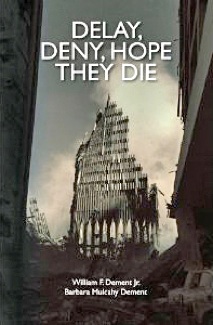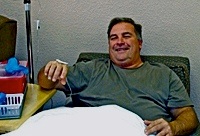“I now choose to run opposite the crowd and I am no longer trampled.”
– William F. Dement –

“I now choose to run opposite the crowd and I am no longer trampled.”
– William F. Dement –

his is the story of a disabled 9/11 first responder, a former police
Lieutenant, N.Y.P.D., who describes himself as an “ordinary joe,”
who drove 2,000 miles in two days from New Mexico to respond
to the World Trade Center disaster. It vividly depicts Bill’s months at
Ground Zero working with the bucket brigade in the Pit, assisting resi-
dents to re-enter their apartments to recover their valuables, and praying
at St. Paul’s Chapel as mourners left cards, photos, and lit candles for
their missing loved ones. It details the every-day horror for those missing

Copyright © 2010-20101 Delay,Deny, Hope They Die. All rights reserved.
A portion of the proceeds will be donated to charity.
Site designed by CreativePartnersnm.com

"Bill and Barbara Dement are master storytellers"
"At the end of day, Delay, Deny, Hope They Die is the telling of a story that must be told."
"This is a hero's journey home on September 11th, the World Trade Center-months in the pit of hell, the daily routines of rescue workers, miracles (St Pauls and the Chapel), the onset of World Trade Center illness, Yankee Stadium and the attempted return to normalcy, American Airlines Flight 587 and the return to reality. Death and despair at the Dump. Illness: delay, denial, and death. This is the untold, enduring story of 9/11 told ten years later by a man that lived it."

loved ones. It details the every-day routine of first responders like eating at the Red Cross mess tent and shows the special bonds that were forged among first responders and volunteers, while honoring the compassion of the many volunteers that came from all across America.

The World's Toughest Book Critics
It describes Bill’s work at the ‘Fresh Kills’ landfill, raking for body parts in bio-hazard suits amid putrid air —
a rat-infested dump where cars contaminated with asbestos and other carcinogens from the W.T.C. sat
piled atop each other, never to be returned to their owners. It chronicles NYC’s attempted return to normalcy
with the resumption of baseball at Yankee Stadium in late September and the sudden return to harsh reality
with Bill’s response to the American Airlines Flight 587 crash in November. It depicts the development of
Bill's 9/11 related illnesses starting with what became known as “W.T.C. Cough.” Witness the N.Y.P.D.'s
Medical Board’s organized obstruction, delay, and ultimate denial of benefits to him and other disabled
first-responders, many of them having developed cancer.
Bill draws on life lessons learned from the Scots-Irish family that adopted him at birth and raised him in
Brooklyn and Staten Island. His adopted father was a W.W.II veteran stationed at Pearl Harbor on the
battleship U.S.S. California prior to the December 7th attack. Bill details his experiences growing up to
become a third generation N.Y.P.D officer. He recounts the wisdom received from his grandmother who
raised him—her recollections of growing up in the gaslight era of the late 1880s in Brooklyn where humility, empathy, and later Depression-era values of frugality, perseverance, and gratitude for the little things in
life were exemplified. Bill reveals how the pain and abuse he suffered at the hands of his adopted mother,
while seeing her spiral into mental illness, shaped his life. He vividly describes the wild ride during the
summer of 2001—his transfer to Narcotics, complete with the dramatic execution of 120 narcotics search warrants, battering rams and the raw reality of the daily ‘war on drugs‘ — which all ended on that fateful
day that was September 11th.